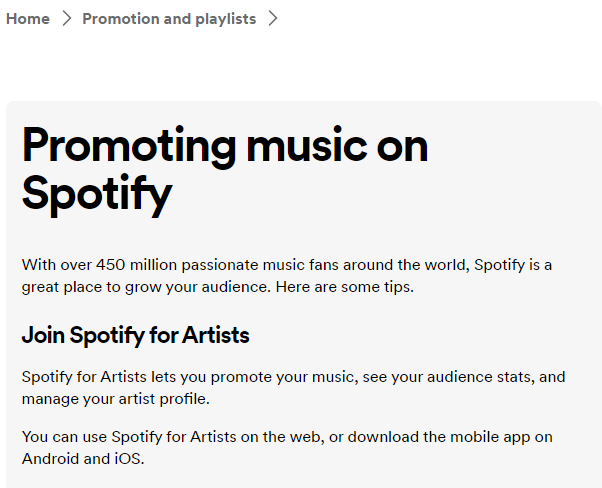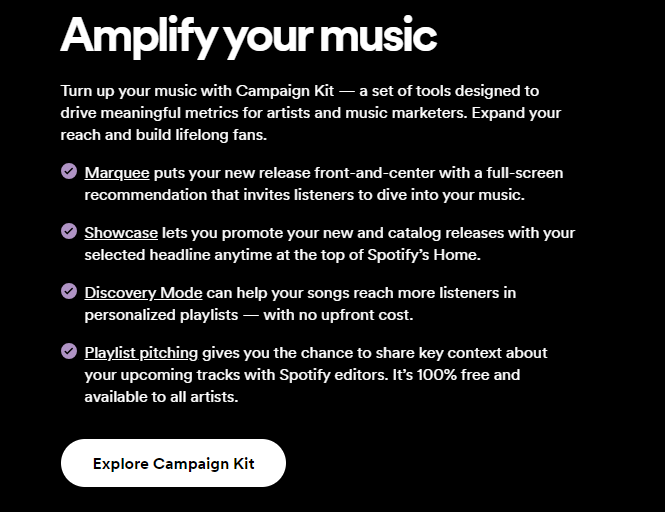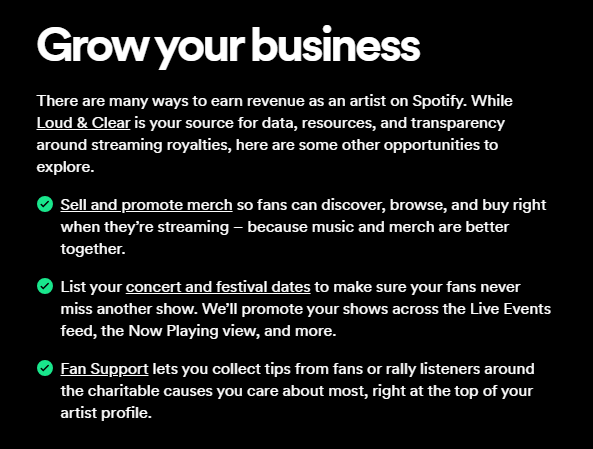If you want to make a name for yourself in the music industry, you know that having a solid marketing strategy is paramount. But let’s be real: the music marketing landscape can be tough to navigate. With everyone vying for the attention of listeners, it often feels like a cutthroat competition against big companies and labels.
Perhaps you’re considering promoting your music on Spotify, but you’re unsure about the platform’s integrity and whether it will yield the results you’re hoping for. If that sounds like you, then you’re in the right place!
Today we’ll break down how Spotify promotions work, the resources and tools available to you, and how to approach third-party services.

What are Spotify Promotions?
In a nutshell, Spotify promotions are strategies for musicians to expose their music and attract more people’s attention on Spotify. You can do different types of promotions for Spotify: the most popular promotions are playlist placements, algorithmic recommendations, and marketing campaigns. If you have joined Spotify for Artists, you already have all these tools within Spotify at your hand.
Using the Spotify for Artists Campaign Kit
Spotify for Artists offers you and your team tools to promote your music. This includes pitching your music to Spotify playlist editors, tools to run campaigns inside Spotify, and ways to share your music on social media and websites.

Playlisting
Spotify for Artists lets you pitch your songs to Spotify editors for a playlist placement. Pitching to playlists can feel daunting, and there is no guarantee that your music will be placed on a playlist, but it can get your track on your followers’ Release Radar playlist. This playlist can help you get your music streamed on the first day of your release, which can then be pushed to other algorithmic playlists.
Getting on more playlists on Spotify is the best way to increase visibility. If you’re able to be featured in several playlists, the platform will consider it a sign that your music is worth recommending to more users and will start placing it in algorithmic playlists. Your music will reach listeners worldwide who may enjoy and like your music and can become your fans and customers who will support you by buying your music and merchandise, going to your concerts, etc.
Playlisting is one of the leading promotions that indie musicians look for, as it can increase your visibility and organically attract more people to your music catalog on Spotify. The most attractive playlists for artists on Spotify are the Release Radar and Discover Weekly, but you’ll have to work your way to get your music in there!
Spotify Built-in Tools
Spotify offers campaign tools that can help you grow your fanbase.
Discovery Mode. With Discovery Mode, you can choose which song Spotify should prioritize to recommend. However, there’s no guarantee that your song will be featured on their playlists.
Commerce tools. For a fee, the Shopify integration allows you to connect your merch store to Spotify for Artists and sell it from your artist profile to your fans.
Ad Studio. You can create ads for Spotify-free members. Choose between Audio Ads that free users will listen to between songs, Video Ads that will appear when the user navigates the app, and podcast ads to reach both premium and free listeners.
Marquee. Marquee is an advertising tool that runs for free and premium users alike. The difference is that they are more naturally included in the app. They will be targeted to users that are more prone to stream your music. It appears as a full-screen pop-up that users can click to start streaming your song, EP, or album.
Showcase. Showcase places your ad at the top of Home in the Spotify app. Every free and premium user will be able to see it when they launch the app in search of what to stream next.
Marquee and Showcase are not available worldwide yet. You’ll have access to Marquee if your team is based in Australia, Canada, France, United Kingdom and United States. Showcase is only available for US teams.
Share your Music
Another simple and organic way to promote your music is the Share option in the Spotify mobile app, desktop, and web player. Click the three dots to display the song, album, or artist context menu and select Share.
You can copy the link, place it on your social media and website, share it with friends, etc. From the mobile app, you can share your song directly to social platforms and display your Spotify Code, which users can scan to go directly to your Spotify catalog.
You can also generate Promo Cards to highlight a milestone, a new release, or your artist’s profile.

Pros and Cons of Built-in Spotify Promotion Tools
While Spotify offers more than enough features to help artists advertise their music, it has its cons and pros like any other service:
Pros:
- Playlisting can help you connect with an audience you otherwise might not have been able to.
- The opportunity to land on Release Radar and Discover Weekly playlists.
- Spotify users are already on the platform looking for music, so it’s easier for them to listen to your music.
- You can access resources to see your results in Spotify for Artists, such as metrics, monitor playlists you’ve been featured in, and data from your stream sources.
- You can trust that Spotify’s promotion is legit.
Cons:
- Pitching to editors is no guarantee of being featured on a playlist.
- Users may not listen to your tracks even if you run Studio Ads, Marquee, and Showcase.
- Even if your music gets streamed, Spotify users may not save it or follow you.
- There’s a lot of trial and error involved.
The Rise of Third-Party Promotion Services
All the benefits of built-in Spotify promotion sound great, but when you start using these tools, you soon realize things are more challenging than you expected, especially for indie artists and small companies just entering the music industry.
The truth is that Spotify playlists can grant you organic streams, but to get there, you need to release music constantly and promote your music professionally. That’s why other companies started to see this as a business opportunity and third-party promotion services began to rise.
These promotion services started as playlist pitching assistance, helping artists with the pitching process so they could focus on making music. They contact user-generated playlist curators to pitch your songs and get you featured in them. It would boost your songs so you could get attention from the Spotify algorithm and eventually get into the Spotify playlists.
As more of these third-party service options emerged, they began offering promotion packages, promising playlist placements, a certain amount of streams, and increased followers. More and more musicians started to use these services and share their results online, but soon, the truth about the legitimacy of some of these services would begin to impact the music industry.
Artists began sharing stories of them having a boost in their streams. However, others also noticed some suspicious things, such as streams coming from unusual areas, disappearing from their stats, or receiving emails from Spotify regarding artificial streaming.
The Concern of Fake Streams
Fake streams or artificial streaming involve manipulating Spotify stream count by computer programs that generate counterfeit accounts that follow the artists and use bots to increase song streams. Some third-party agents use these methods to scam artists for a fee, but the consequences can be devastating for the artist.
Artificial streaming violates Spotify’s terms and conditions, which clearly state that accepting or giving any form of payment in exchange for playlist placement, increasing followers, and streams using automated processes like bots and scripts is prohibited. As a result, your music might be removed from Spotify, losing your royalty income and account.
Streaming fraud became a worldwide issue as these practices continued, causing a loss of $1 billion in streaming royalties. In November 2023, Spotify released a statement announcing new policies to address the situation. These changes include penalty fees to labels and distributors for each of their tracks flagged with fake streams.
Examining the Authenticity of Third-Party Services
There are still many concerns about whether using third-party services is illegal. Yes, there are scams out there, but there are also people who genuinely help artists, advising that placement is not guaranteed and only accepting payment after they’ve delivered results, which can be from regular to incredible.
There are tons of playlist curators who own playlists with organic streams. Legitimate third-party services usually have connections with them, so they can contact them to pitch songs from the artists and labels that hired their services. However, finding genuine promotion opportunities can be challenging.
I compiled a few tips on verifying if the services provided by a third-party company are legitimate and how to protect yourself against streaming fraud. These are tips shared among artists who have been affected to warn others.
- Preferably use renowned curators and third-party services. SubmitHub, Playlist Push, Groover, and YouGrow Promo are a few options that have a good reputation.
- If you have not heard of the company or provider, do some research before setting up a deal with them. Look for reviews, contact them, and ask questions about which playlists they will pitch. I would think they’re hiding something if they refuse to provide more work details.
- If the playlists they’re pitching have thousands of repeated songs in a mix of genres, it could be a red flag. It’s best to pitch to playlists with music in your genre.
- Usually, when something seems too good to be true, it’s too good to be true. If they promise you thousands of “real” streams and followers for $50, think twice about dealing with them.
- If you suspect you’ve been a victim of artificial streaming, you can use Spotify for Artists’ analytics or external tools like Chartmetric to verify your streams and playlist stats.
- Search for consistent growth in a playlist. A playlist with fake streams will present spikes in follow and stream counts when Spotify eliminates fake accounts from its database.
Pros and cons of using Third-Party Promotions Services
There are some pros and cons of using genuine third-party services. I highlight a few here so you can plan how to approach them.
Pros:
- They will take care of the pitching process for you so you can focus on creating more high-quality music, avoiding the burnout of promoting.
- These companies have contacts with curators, music bloggers, and other playlists and know which ones your music will fit best.
- Some of these services offer playlisting on other music platforms and other marketing strategies, such as advertising on social media, building a website, and social media management.
Cons:
- There’s no guarantee of playlist placement or stream and follower growth.
- Costly prices for the service.
- Risk of being placed on fake playlists and its consequences.
Alternative Strategies for Visibility
What can you do if you prefer to avoid using a service that is against Spotify’s user guidelines?
You can rely on organic growth through content on social media, collaborations with other artists, curators, music bloggers, and local radio stations (offline promotions can also drive listeners to Spotify).
As a general rule, it’s always good practice to combine paid and organic promotion. It’s better to begin with organic content, especially if you’re starting to release music or have a tight budget. When organic content is thriving, you can reuse it for ads. It will take some time to see results, but you can rest assured that your streams will come from real people, and you can grow your fanbase organically.
- Create engaging content on social media: Facebook, YouTube, TikTok, Instagram, etc.
- Share your music online using your Spotify links.
- Contact other artists in your music genre and propose a collaboration that could benefit both.
- Contact influencing music bloggers and playlist curators.
- Participate in networking opportunities online and offline.
- Start an email list and engage with your fans. One of the benefits of an email list is that you own the data and can still reach out to your fans even if you change your email marketing provider.
Final Words
So, are there real Spotify promotions?
While there are a few factors concerning the security, transparency, and authenticity of these third-party promotion services, you can still benefit from these services by taking precautions and using the advice given to distinguish genuine services from scams.
Remember there are pros and cons for every service and that sometimes the results will differ from what you expect. Be realistic about your expectations and goals, work with the most trusted promotion services, use Spotify’s built-in tools, and prioritize long-term fanbase growth and building relationships with other content creators, artists, and followers.
Good luck!








